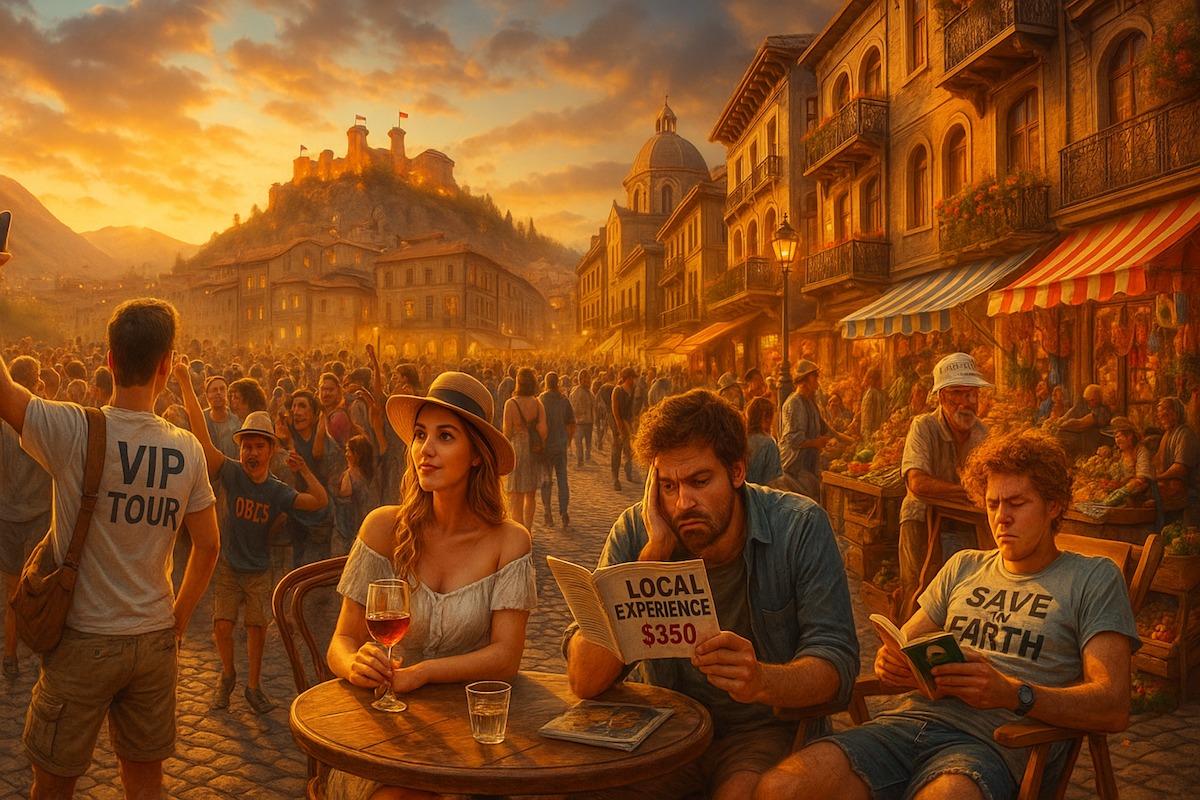Contents
- Think You’re Booking the Trip of a Lifetime? Think Again.
- 1. The “Hidden Gem” Hype Is Creating Tourist Traps Overnight
- 2. Slow Travel? Great… Until It Becomes Expensive Procrastination
- 3. The Revenge Travel Backlash: Crowds, Chaos, and Cancellations
- 4. Eco-Tourism Gone Wrong: The Hidden Carbon Costs No One Talks About
- 5. Luxury Hostel Scam: Paying Hotel Prices for a Bunk Bed
- 6. Authenticity Theater: How ‘Local’ Experiences Are Now Scripted
- 7. Subscription Travel Clubs That Promise the World… and Deliver Headaches
- 8. Social Media-Fueled “Must-Sees” That Are Actually Major Letdowns
- Ditch their Hype, Find your Story
Think You’re Booking the Trip of a Lifetime? Think Again.
Why Following the Wrong Trends Could Wreck Your Next Trip, and How Savvier Travelers Are Outsmarting the Crowd!
Back when I first traveled to Europe, the only “travel trend” was getting lost on purpose.
No VIP passes to secret olive groves, no staged “authenticity” tours, and definitely no influencers trying to turn every crumbling alley into the next Amalfi Coast.
You just showed up, winged it, and maybe came home with a story about questionable tapas and train schedules that defied the laws of physics.
Fast-forward to 2025, and travel looks more like performance art.
It’s not enough to visit a place anymore, you have to optimize it for TikTok, drop $300 on a “local experience” run by an intern who calls himself a “journey architect,” and fight through crowds bigger than Paris’s metro at rush hour just to snap a photo nobody will believe is real.
One of my former teaching students from Ukraine tried booking a “slow travel eco-retreat” in southern France.
For $800, they got three nights in a glorified goat shed, no hot water, and a carbon footprint guilt-trip delivered by a college kid wearing a “Save the Earth” T-shirt made in Bangladesh.
Turns out, chasing trends doesn’t guarantee authenticity, it just guarantees you’ll get scammed with better marketing.
So if you’re dreaming of the perfect trip this year, maybe hold off before blindly following the latest “must-do” list clogging your feed.
Because behind the hashtags and drone shots, there are landmines just waiting to blow up your vacation, and your wallet.
Here are 8 brutal ways travel trends could be wrecking your trip before it even begins, and how to dodge the fallout.
1. The “Hidden Gem” Hype Is Creating Tourist Traps Overnight
The first time I wandered into a dusty little bar in León, Spain, was in 1998 while I was walking the Camino de Santiago.
It was empty except for a bartender polishing glasses and a soccer game blaring in the background.
Nobody cared who I was.
Nobody took photos of their drinks. It was perfect.
Fast forward to 2015: That same alley now had a velvet rope, a themed cocktail menu, and an “experience curator” at the door asking if you ha a reservation, for a bar that once didn’t even have chairs that matched.
I can’t even imagine what it’s like now…
What happened? Social media happened. Camino tourism happened.
Hollywood happened!
Every so-called “hidden gem” has been blown sky-high by a thousand TikToks promising “authenticity” and Martin Sheen’s 2010 movie “The Way”.
Translation: crowds, prices tripled, locals visibly wishing you would all vanish.
How-to Dodge: Don’t believe the hype. Always check recent visitor reviews on local forums, not curated travel lists.
A true hidden gem doesn’t need branding, and probably doesn’t have Wi-Fi either.
2. Slow Travel? Great… Until It Becomes Expensive Procrastination
When I lived in large town outside of Strasbourg, France, I thought I was slow traveling like a wise old sage.
I spent days sitting in cafés where coffee cost less than a deep breath back home, practicing terrible French, getting lost in cobblestone alleys, and loving minute of it.
By week three, “slow travel” started feeling suspiciously like slow motion bankruptcy.
My “deliberate cultural immersion” basically meant bleeding money on overpriced pastries and museum tickets I kept meaning to visit but somehow never did.
The romantic idea of “taking your time” sounds noble until you realize you’re just floating aimlessly through someone else’s daily grind while your budget quietly dies.
How-to Dodge: Give your slow travel some structure.
Set goals: a museum visit, a language lesson, even just a hike outside the city.
Otherwise, you’re not slow traveling… you’re just renting boredom at a premium.
3. The Revenge Travel Backlash: Crowds, Chaos, and Cancellations
I used to think nothing could top the mosh-pit density of Kyiv’s metro system during a snowstorm: shoulder to shoulder, unspoken agreements about bodily contact long since abandoned.
Then I made the mistake of visiting Barcelona’s Gothic Quarter at noon one summer.
Imagine the same shoulder-to-shoulder crush, but now everyone’s wielding a selfie stick, live-streaming bad flamenco moves, and yelling at security guards about why they can’t fly drones over 600-year-old cathedrals.
No wonder why locals have been up in arms over the tourist invasion.
Meanwhile, hotels were overbooked, airlines pretended boarding passes were optional, and customer service agents developed the thousand-yard stare of soldiers in trench warfare.
How-to Dodge: If you must travel during peak season, book mid-week flights, avoid Instagram-famous sites during daylight, and always, always confirm every single reservation twice.
Otherwise, you might end up sleeping on the airport floor next to a guy live-streaming his suffering for views.
4. Eco-Tourism Gone Wrong: The Hidden Carbon Costs No One Talks About
In Thailand, I once signed up for an “eco-tour” that promised minimal environmental impact.
They handed out plastic water bottles, packed us into diesel vans, and drove four hours to an “untouched” jungle outpost sandwiched between a shack masquerading as a convenience store and a billboard for luxury condos.
I calculated later that my “green experience” burned more fossil fuel than if I had just stayed home binge-watching documentaries about whales.
How-to Dodge: “Eco” isn’t a sticker someone slaps on their website… it’s a set of actual, painful choices.
Want to be eco-friendly? Walk more. Fly less.
Stop mistaking green marketing for green behavior.
5. Luxury Hostel Scam: Paying Hotel Prices for a Bunk Bed
During a trip to Milan, I got lured in by ads for a “luxury hostel experience.”
What they meant was colorful LED lights, wobbly IKEA bunk beds, and a “gourmet breakfast” that turned out to be instant coffee (in Italy!) and a rock-hard Cornetto, all for $75 a night.
And the air conditioning? Coin-operated, of course.
Meanwhile, in the shared kitchen, backpackers fought over two pots and a stove that only worked if you jammed a fork under the burner, while someone butchered Wonderwall on a beat-up guitar at 2 AM.
How-to Dodge: If you’re paying hotel prices for the privilege of communal showers and 3 a.m. drunken serenades, you’ve been had.
Always read the hostel fine print. “Boutique” is not a synonym for “basic human decency.”
6. Authenticity Theater: How ‘Local’ Experiences Are Now Scripted
A fellow traveler in Tuscany swore she had booked the “ultimate Italian cooking class with a local grandmother.”
In reality: the “grandmother” turned out to be a twenty-something drama major “dude” who spent more time flirting than explaining why his “secret family recipes” looked suspiciously like they came off Pinterest the night before.
The whole thing felt about as authentic as a theme park parade, but with worse pizza.
How-to Dodge: If an experience feels suspiciously tailored to look good on Instagram, it probably was.
Trust your gut: real local interactions don’t come with choreographed photo ops.
7. Subscription Travel Clubs That Promise the World… and Deliver Headaches
One of my former students got sucked into a glossy subscription travel club offering “luxury stays at unbeatable prices.”
They spent $1,700 for a week at a hotel so bleak it made Soviet-era buildings look festive, located next to some recycling plant in the outskirts of Brussels.
When they tried to cancel, the club responded with a 14-page PDF outlining their “extensive satisfaction protocols.”
And guess what? None of them involved refunds.
How-to Dodge: Travel subscription clubs are often like gym memberships: easy to join, impossible to escape, and full of sweaty disappointment.
If you can’t see flexible terms upfront, run.
8. Social Media-Fueled “Must-Sees” That Are Actually Major Letdowns
If you think the Cinque terre is going to look like those pristine influencer shots you see online, prepare yourself.
It’s a full-contact sport: elbowing for photo space, dodging aggressive tour operators, and contemplating your travel choices as you pay $15 for a lukewarm espresso in a café that spells “cappuccino” wrong.
I know because I lived it, one overpriced gelato at a time.
How-to Dodge: Skip the trending hashtags.
Some of the best places I’ve ever seen, back alleys in Pamplona, sleepy side streets in Krakow, were never trending, and thank God for that.
Ditch their Hype, Find your Story
In 2025, real travel isn’t about where you go… it’s what you refuse to chase.
It’s that sleepy square in Spain no one’s snapping selfies in.
It’s the crooked little bookstore in Avignon that smells like dust and freedom, not marketing.
Before you book that influencer-approved “dream trip,” ask yourself:
Are you chasing your dream… or someone else’s highlight reel?
What trend burned you the most?
Because the smartest travelers in 2025 aren’t following trends.
They’re quietly outsmarting them.

David Peluchette is a Premium Ghostwriter/Travel and Tech Enthusiast. When David isn’t writing he enjoys traveling, learning new languages, fitness, hiking and going on long walks (did the 550 mile Camino de Santiago, not once but twice!), cooking, eating, reading and building niche websites with WordPress.

